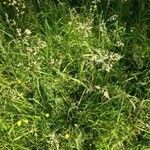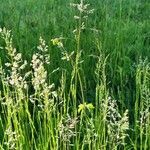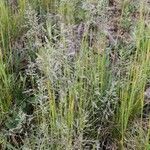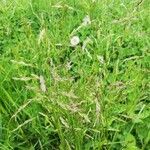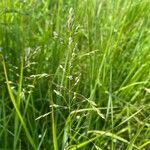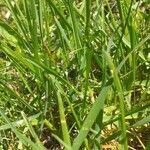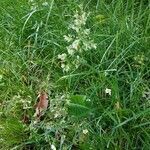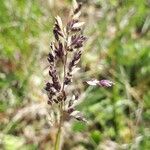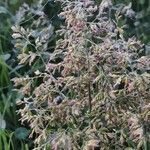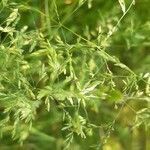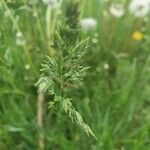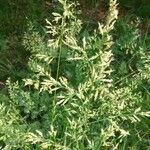Rather narrow, loose to compact perennial tufts c. 10-50 cm from slender rhizomes with ± soft, bright green to greyish green leaves < culms; branching extravaginal at plant base, sometimes intravaginal above; leaf-blades persistent. Leaf-sheath light green to very light brown, membranous to ± coriaceous, distinctly ribbed, glabrous, or slightly short-scabrid to shortly hairy near ligule. Ligule in lower leaves 0.2-0.5 mm, truncate, often very short-ciliate, and abaxially minutely hairy, in upper leaves 1-2 mm, apically glabrous, entire and rounded. Leaf-blade (1.5)-10-20-(35) cm × (1.5)-2-4 mm, flat or folded, subcoriaceous, glabrous or sparsely finely hairy especially near ligule or only adaxially; margins sparsely scabrid to smooth, sometimes hairy near ligule; midrib scabrid near blunt, curved tip. Culm (5)-20-55 cm, internodes glabrous. Panicle (2)-5-10-(15) cm, ovate to pyramidal, or oblong, erect or nodding, loose and open to somewhat dense and contracted; rachis glabrous, branches in clusters of 3-5, spreading, filiform, flexuous, smooth or finely scabrid with spikelets clustered at tips. Spikelets 4-6 mm, (2)-3-6-flowered, light green or purplish. Glumes ± unequal, acute, membranous, midnerve scabrid; lower 1.5-3 mm, 1-3-nerved, narrow-ovate, upper 2-3.5-(4) mm, 3-nerved, ovate-elliptic. Lemma 2.5-4 mm, 5-(7)-nerved, ovate-oblong, subobtuse to acute, midnerve and marginal nerves thinly to densely hairy in lower ½, midnerve finely scabrid above hairs, internerves glabrous. Palea 2-3 mm, keels finely scabrid, interkeel glabrous. Callus with tuft of long crinkled hairs. Rachilla c. 0.5 mm, glabrous or very minutely sparsely papillose; prolongation twice as long. Lodicules 0.6-0.8 mm. Anthers 1.2-1.7 mm. Caryopsis c. 1.5 × 0.5 mm, tightly enclosed by anthoecium.
Variable rhizomatous perennial, sometimes loosely caespitose. Culms 10–71 (–90) cm high, erect or geniculate; mid-culm internodes glabrous. Young shoots mostly extravaginal. Leaves: basal sheaths with margins connate in lower 1/3–1/2, glabrous or rarely puberulous, rarely purplish; ligule 0.9–3 mm long, obtuse to truncate, apically glabrous or ciliolate, abaxially glabrous or puberulous; blade flat or weakly folded, 6–19.5 (–30) cm long, 1.7–5 mm wide, somewhat hooded at apex, adaxially glabrous, abaxially glabrous or scabrous, often subglaucous. Panicles open to contracted, 3.5–12 (–20) cm long. Spikelets (2.5–) 4.3–6 mm long, with 2–6 bisexual florets. Glumes: lower glume (1.5–) 2.1–2.8 (–3.5) mm long, (1–) 3-nerved; upper glume (2–) 2.6–3.4 (–4) mm long, 3–5-nerved, with marginal nerves short. Web well-developed. Lemma (2–) 3.1–4 mm long, 5-nerved; keel and marginal nerves sparsely hairy to villous in lower 2/3; intermediate nerves usually glabrous; intercostal regions glabrous. Anthers 1.5–1.9 mm long, occasionally aborted in some florets.
Rhizomatous, forming a dense sod, or in tufts on long rhizomes in open ground; culms 3–10 dm; sheaths usually glabrous; blades soft, 2–5 mm wide, seldom narrower and involute; ligule shorter than wide; infl ovoid, fairly dense, with spreading or ascending branches, the lower mostly in sets of 5 or 4; spikelets 3–5-fld, with very short rachilla-joints; first glume 1.8–2.9 mm, the second 2.3–3 mm; lemmas distinctly 5-veined, thinly to densely hairy on the veins below but glabrous between them, webbed at base, the lowest 2.5–3.5 mm; anthers 1–1.4 mm; 2n=21–147. Moist or dry soil, avoiding acid soils and heavy shade, throughout the U.S. and far n., often cult. in lawns and meadows; in most of our range intr. from Europe, but probably native along our n. boundary and in Can. (P. angustifolia; P. subcaerulea) Some nematode-infested plants in the ne. part of our range have notably larger, 7-veined lemmas and often a reduced and stiff infl.
Loosely to compactly tufted perennial, 250-600(-800) mm high; rhizome long, wiry. Leaf blade 60-250 x 2-5 mm, flat or rolled; ligule a fringed to unfringed membrane, truncate to rounded, 0.5-2.0(-3.0) mm long. Inflorescence an ovate panicle, 50-200 mm long; lowest branches whorled, branches of up to 6 fascicles; spikelets aggregated on upper part of branches. Spikelets 3.0-5.5(-7.0) mm long, laterally compressed, awnless; glumes ± equal to unequal, shorter than spikelet; lower glume 1-3-nerved; upper glume 3-nerved. Florets 2-5; lemma entire, 5-7-nerved, keeled, woolly at base on keel and margins; palea ciliate on keels; anther 1.5-2.0 mm long. Flowering time Sept.-Jan. (Apr.
Loosely to compactly tufted, highly variable perennial 250-600(-800) mm high; rhizome long, stout and wiry or absent. Leaf blade 60-250 x 2-5 mm, flat or rolled; ligule truncate to rounded, 0.5-2.0(3.0) mm long. Inflorescence 50-200 mm long, ovate, lowest node with 3-6 branches; branches smooth or scabrid, less than own length apart; spikelets aggregated on upper part of branches. Spikelet 3.0-5.5(7.0) mm long, 2-5-flowered; lower glume 1-3-nerved; lemma 5-nerved, distinctly muriculate, keels and margin densely hairy to middle, base with long fine woolly hairs; palea keels ciliate to scabrid; anthers 1.2-2.0 mm long.
Perennial; up to 0.6 m high; loosely to compactly tufted or with long rhizome; stout and wiry or absent. Leaf blades 60-250 x 2-5 mm; upper ligules truncate; rounded to obtuse; up to 2(3) mm long; basal sheaths usually not fibrous. Flowers: panicle open; ovate; 50-200 mm long; lowest branches whorled; spikelets 3.0-5.5 mm long; spikelets 2-5-flowered; aggregated on upper part of branches; keels and margins densely hairy to middle; base with long fine woolly hairs; anthers 1.5-2.0 mm long.
Perennial, loosely to compactly tufted or rhizomatous (rhizome long and wiry), up to 0.6 m high. Leaf blades 60-250 mm long, 2-5 mm wide; ligules truncate, up to 2 mm long. Spikelets 3.0-5.5 mm long. Panicle ovate, 50-200 mm long, lowest branches whorled; spikelets 2-5-flowered, aggregated on upper part of branches; lemma keel and marginal veins pilose; anthers 1.5-2.0 mm long.
A grass which keeps growing from year to year. It has creeping underground stems or rhizomes. The stem is erect. It grows 10-90 cm high. The leaves are flat and pliable. The flower panicle is oval shape. It is 2-20 cm long. The spikelets are oval and 4-6 mm long. There are 2-5 flowers.
Like P. binata but lowest panicle branches whorled, basal sheaths not fibrous and lemmas woolly below.
